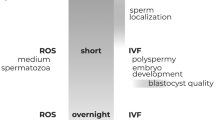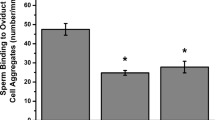Abstract
IT has been reported that the uptake of oxygen by rabbit spermatozoa increased four-fold after they had been incubated for 6 h in the uterus of the œstrous rabbit1. It has also been postulated that the capacitation of spermatozoa may be associated with changes in their metabolic pattern to enable them to produce more energy2. This communication deals primarily with the metabolism of freshly ejaculated sperm and those incubated in the uterus of the œstrous rabbit. The host rabbit was anæsthetized with ‘Nembutal’ and the uteri were ligated anterior to the cervix and posterior to the uterotubal junction. The freshly ejaculated somen from 3 to 7 bucks, to which streptomycin (2 mg/ml. semen) was added, was divided into 3 portions. One portion was heated at 65° C for 10 min to kill sperm and then injected into the left uterine horn. Another portion with live sperm was injected into the right uterine horn of the same rabbit. The third portion was washed3 and resuspended in Ca++ free Krebs–Ringer phosphate4, for immediate metabolic studies. Semen deposited in the uterus was collected 6 h later by introducing 5–10 ml. Krebs–Ringer phosphate into each uterine horn and then withdrawing with a syringe. The uterine washing from each horn was diluted with Krebs–Ringer phosphate to make a final volume of about 25 ml. and then centrifuged (1,000g) for 15 min. The supernatant was discarded and the sediment was resuspended in Krebs–Ringer phosphate. The suspension recovered from the left uterine horn contained leucocytes and was free of any live sperm. Counts of sperm and leucocytes were carried out and correction was made for the contamination of leucocytes1. Aliquots (0.8 ml.) of each of the three suspensions were placed in Warburg vessels (6 ml. capacity) and 0.2 ml. Krebs–Ringer phosphate containing 10–15 µmoles of carbon-14 labelled glucose (specific activity : 5 µc./ml.) was added. In the first three experiments uniformly labelled glucose was used, and in the fourth experiment glucose-1-14C was used. In experiments 5–7 glucose-1-14C and glucose-6-14C were used as substrates. Incubation of fresh sperm in the Warburg apparatus (37° C) was carried out directly after they had been washed, and of the in utero incubated sperm and leucocytes soon after they had been collected. The 14CO2 released was trapped with hyamine hydroxide and a strip of filter paper that had been placed in the central well of the Warburg vessels. After incubation for 2 h, 0.1 ml. 3 N perchloric acid from the side-arm was tipped to stop the reaction and to liberate any 14CO2 that might have been present in the medium. The radioactivity of both the substrate and the trapped 14CO2 with hyamine and filter paper was determined by means of a scintillation counter. Glucose and lactate were estimated as previously described5. Lactate production was corrected for any lactate that had been present before incubation.
This is a preview of subscription content, access via your institution
Access options
Subscribe to this journal
Receive 51 print issues and online access
$199.00 per year
only $3.90 per issue
Buy this article
- Purchase on Springer Link
- Instant access to full article PDF
Prices may be subject to local taxes which are calculated during checkout
Similar content being viewed by others
References
Hamner, C. E., and Williams, W. L., J. Reprod. Fertil., 5, 143 (1963).
Mounib, M. S., Acta Endocrinol. (in the press).
Terner, C., Amer. J. Physiol., 198, 48 (1960).
Cohen, P. P., in Umbreit, W. W., Burris, P. H., and Stauffer, J. F., Manometric Techniques, revised ed., 149 (Minneapolis 15, Minn.: Burgess Publishing Co., 1957).
Mounib, M. S., and Chang, M. C., Rad. Res. (in the press).
Fridhandler, L., Exp. Cell Res., 22, 303 (1961).
Chang, M. C., Nature, 175, 1036 (1955).
Author information
Authors and Affiliations
Rights and permissions
About this article
Cite this article
MOUNIB, M., CHANG, M. Effect of in utero Incubation on the Metabolism of Rabbit Spermatozoa. Nature 201, 943–944 (1964). https://doi.org/10.1038/201943a0
Issue Date:
DOI: https://doi.org/10.1038/201943a0
This article is cited by
Comments
By submitting a comment you agree to abide by our Terms and Community Guidelines. If you find something abusive or that does not comply with our terms or guidelines please flag it as inappropriate.



